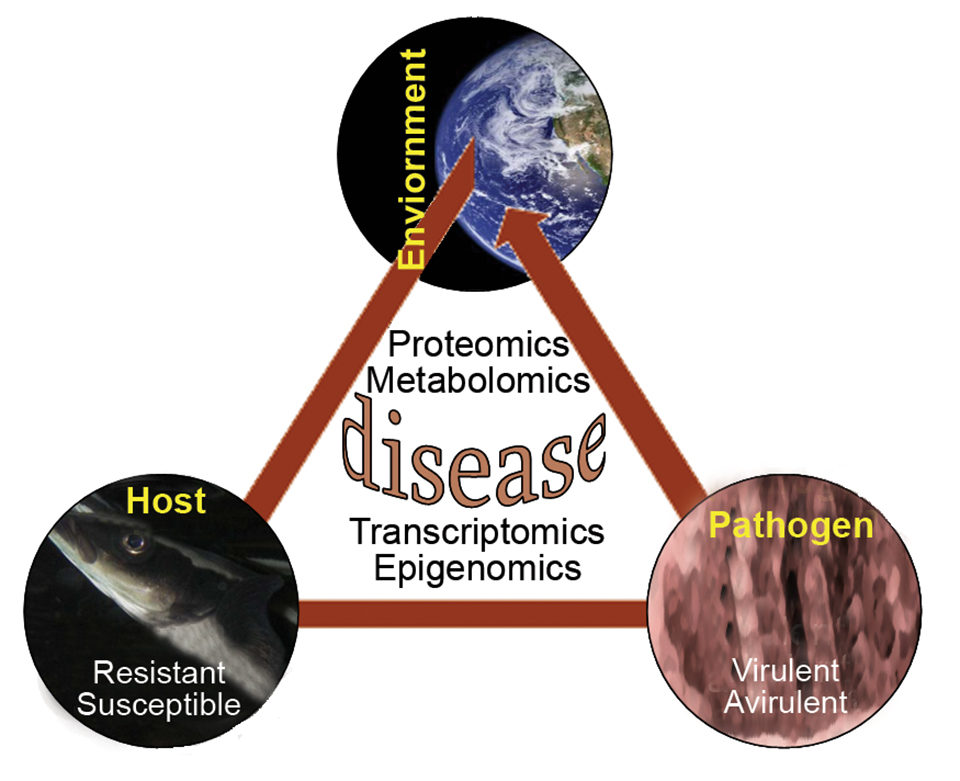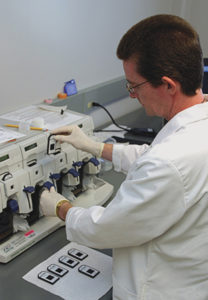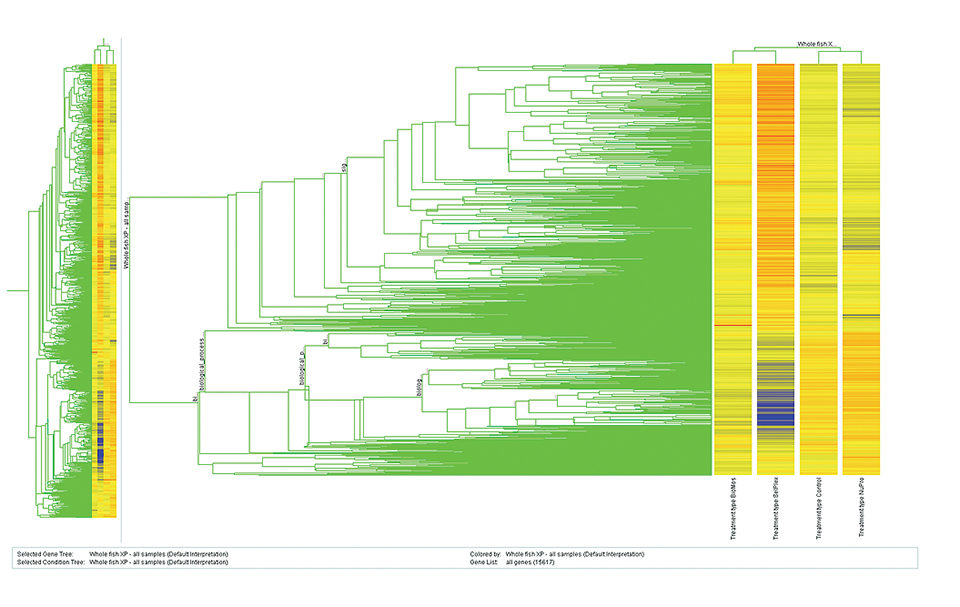Scientists can develop elite feeds with positive effects on production economics and animal welfare

Good nutrition promotes good health, while dietary imbalances can lead to illness. Some people and populations are more prone to nutritionally driven ailments than others, and many nutrition-related illnesses have a genetic basis.
Nutrients modify gene expression by altering normal metabolic processes. Clinical nutritionists are using novel approaches to better understand disease processes. Key weapons in the nutrition arsenal include a growing number of molecular techniques that enable the dissection of interrelationships among diet, health, and disease processes. A central figure in the nutritional armory is a subdiscipline of functional genomics, termed nutritional genomics or “nutrigenomics.”
Nutrigenomics
Nutrigenomics is the study of how foods affect genes and how individual differences in genetic makeup affect the ways in which animals respond to nutrients with regard to health. Enhanced understanding of how dietary chemicals impact human and animal health will improve our ability to develop methods to prevent and cure many nutrition-related ailments.
Nutrigenomics uses a number of “-omic” disciplines, including transcriptomics, proteomics, metabolomics, and epigenomics. The huge data sets generated by this research rely heavily on the field of bioinformatics, which has developed new methods to acquire, store, share, analyze, present, and manage the information. These techniques provide powerful means to monitor numerous and sometimes negligible genomic changes.
Genomics and aquaculture
Functional genomics – the combination of genomics, proteomics, genotyping, transcriptomics, and metabolomics – has expanded rapidly over the last decade, but research on important aquaculture species is still relatively uncommon. Transcriptomics studies using microarrays represent important components of nutrigenomic research, since they highlight the impacts of different treatments on the activation or silencing of specific genes.
Certain affected genes may offer commercial benefits such as enhancement of immune function or stress resistance, and thus may be targeted via nutritional intervention to increase the performance or welfare of the cultured animal. Microarray technologies have examined treatment effects on abalone, shrimp, zebrafish, fugu, medaka, puffer fish, rainbow trout, Atlantic salmon, gilthead sea bream, sea bass, and catfish.
Due to the commercial availability of zebrafish microarrays, research at the Virginia Tech Aquaculture Center has concentrated on this species. Three entities cooperate in the program: the College of Natural Resources Department of Fisheries and Wildlife Sciences, the Virginia Bioinformatics Institute Core Laboratory Facility, and the Virginia-Maryland Regional College of Veterinary Medicine Department of Large Animal Clinical Sciences.
The center’s research examines the impacts of various dietary modifications on gene expression profiles in homologous (zebrafish) and heterologous (tilapia and cobia) species. Important components of this research were to present gene expression data and to illustrate their biological effects.
Nutrients change genes

Nutrition is a very important area of study for aquaculture. By increasing understanding of dietary manipulation effects on fish production, scientists can develop elite feeds with positive effects on production economics and animal welfare, and develop “designer fish” that target specific market demands. To date, significant progress has been made toward elucidating the potentially valuable effects of dietary minerals and immunostimulants on animal health and developmental processes.
In their studies investigating dietary supplementation with organic selenium, a mannan oligosaccharide and organic protein source, the authors identified profound and similar impacts on gene expression in whole animal and intestinal samples from zebrafish and tilapia. The importance of these studies is several-fold.
Firstly, because the identical treatments impacted specific genes and gene sets similarly, these results suggested that the zebrafish microarray can, with caution and validation, be applied to heterologous species. This could be a vital finding, since so few species-specific micro-arrays are commercially available. Moreover, producing said microarrays is prohibitively expensive. However, further validations of these observations must be undertaken.
Secondly, comparison of gene expression profiles from both whole animal and intestinal samples indicated that specific tissues or organs of interest must be targeted for analysis to avoid dilution artifacts. Thirdly, the results categorically illustrated genomewide affects of dietary manipulation.
For example, data analysis of fish fed organic selenium demonstrated that over 1,100 genes were upregulated, of which 30 percent were involved in enzymatic actions. The magnitude of response of specific genes was also much higher in zebrafish fed organic selenium, resulting in responses of sixfold or higher, up to a 14-fold increase in gene expression in one instance.
The current challenge is to identify the specific metabolic pathways affected by the genes in question. Some of these may provide characteristic signatures associated with a particular physiological status. In fact, a major issue requiring resolution is the current lack of availability of validated biomarkers that are specific, sensitive, predictable, and quantifiable.
Once microarrays reveal potential biomarkers, their applicability and value must be validated using other methods, such as quantitative reverse-transcriptase-polymerase chain reaction, Northern or Western blotting, or quantifying protein levels by enzyme-linked immunosorbent or similar assays.

More arrays needed
Research at Virginia Tech Aquaculture Center employs transcriptomics technology to examine how to enhance the welfare of cultured fish and manipulate production for the benefit of producers, processors, and consumers. Yet nutrigenomics-related research regarding aquaculture remains at an early stage of development.
A critical requirement for advancing nutrigenomics in aquaculture will be to develop rigorously validated heterologous microarrays or species-specific gene chips. Alternatively, the production of miniarrays, wherein specific groups of genes involved in nutrition and immune function are represented, may provide a more rapid and cost-effective application of the technology.
(Editor’s Note: This article was originally published in the January/February 2007 print edition of the Global Aquaculture Advocate.)
Now that you've finished reading the article ...
… we hope you’ll consider supporting our mission to document the evolution of the global aquaculture industry and share our vast network of contributors’ expansive knowledge every week.
By becoming a Global Seafood Alliance member, you’re ensuring that all of the pre-competitive work we do through member benefits, resources and events can continue. Individual membership costs just $50 a year. GSA individual and corporate members receive complimentary access to a series of GOAL virtual events beginning in April. Join now.
Not a GSA member? Join us.
Authors
-
Ewen McLean, Ph.D.
Virginia Polytechnic Institute and State University
Virginia Tech Aquaculture Center
1 Plantation Road
Blacksburg, Virginia 24061-0321 USA -
Steven R. Craig, Ph.D.
Virginia Polytechnic Institute and State University
Virginia Tech Aquaculture Center
1 Plantation Road
Blacksburg, Virginia 24061-0321 USA -
Johanna C. Craig, Ph.D.
Virginia Polytechnic Institute and State University
Virginia Tech Aquaculture Center
1 Plantation Road
Blacksburg, Virginia 24061-0321 USA
Tagged With
Related Posts

Intelligence
A brief look at genetically modified salmon
If approved by FDA, fast-growing genetically modified salmon will provide a safe and nutritious product similar to other farmed Atlantic salmon.

Health & Welfare
A holistic management approach to EMS
Early Mortality Syndrome has devastated farmed shrimp in Asia and Latin America. With better understanding of the pathogen and the development and improvement of novel strategies, shrimp farmers are now able to better manage the disease.

Health & Welfare
AHPN inferences based on behavior of vibrio bacteria
Vibrio parahaemolyticus, a strain of which is the cause of acute hepatopancreatic necrosis (AHPN), has both virulent and benign strains. This strain colonizes the stomachs of shrimp by the formation of a biofilm, which protects it from antibiotics and other potential treatments.

Health & Welfare
Alphavirus replicon particles potential method for WSSV vaccination of white shrimp
A study demonstrated that VP19 and VP28 white spot syndrome virus envelope proteins expressed by replicon particles provided protection against mortality due to WSSV in shrimp.


